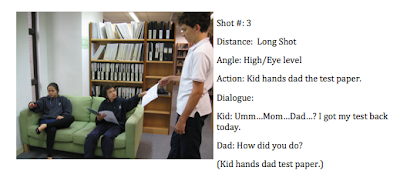Monday, February 28, 2011
First Class Editing
Last class, we edited our short film. For some of the lesson, another group asked my to go and help them film a part since they were an all guy group and they needed a girl. So for the first part of the lesson i was up at the 9th floor helping them film the scene. After returning to editing we encountered some difficulties when trying to make a freeze frame at the end of one scene. We also had difficulties when we tried to add titles and credits because we could not find the button which lets us add the credits. In the end, we figured it all out but then when we watched it through from the top, we found that in the middle of the clip, there was a random 'un-rendered' screen came up. Though we didn't have enough time to try and fix that last class, so we have to try and figure it out in tomorrows lesson.
Tuesday, February 22, 2011
Refined Story board 1 & Filming 1 Reflection
Filming the storyboard.
Yesterday, during class, we started and finished filming our first short scene. When we were filming the scene, we got distracted because we found the scene hard to concentrate because we were laughing at what each other were doing. Though in the end we got it done in time to transfer all the videos into the computer. My favorite part of our first film/scene is the very last part. In the very last part of the scene, i 'slap' Alistair because i am playing a chinese mum who gets mad at her son for not doing well on his exam. Our AOI focus is health and social education. According to the IB Middle Years Program, in Health and Social Education "there must be a balance between physical, social-emotional and intellectual health." - http://internet.savannah.chatham.k12.ga.us/schools/cms/Pages/InternationalBaccalaureateMiddleYearsProgramme.aspx
I think that our short scene captures this because it shows just about the exact opposite of what is said in the quote above. In our scene, we show that our character - the kid, is afraid of his parents - this is not a mentally, physically or emotionally healthy at all. Him being afraid of his parents is shown when he talks. At the start when he says "Umm... Mum... Dad... ? I got my test back." He is talking in a wavering voice. Overall during the filming process, i think we did really well. Looking through the tapes on what we filmed, i think that our scene will be very good and come together nicely.
Camera Angles, Camera Movement, Distance Shots
In class last lesson we learned about the different camera angles and shots.
3. Dolly Shots
A Dolly shot is when the camera is placed on a moving vehicle and is following a subject. This shot can be used in Action or Thriller movies. It is good for showing movement or a chase scene.
Distance Shots
1 . Extreme long shot
The Extreme long is a shot taken from a distance but has really good quality. They are used in the start and ends of movies, news tapes.
 |
| Extreme Long Shot http://mclarkemedia.files.wordpress.com/2010/10/extreme_long_shot.jpg |
2. Long Shot
A Long Shot is a shot of someone who is "Life Size". The shot includes a full body shot of the subject.
 |
| Long Shot http://www.la-story.com/upload/2008/02/van_cleef_arpel_scores_a_hit_with_jennifer_garners/jennifer-garner-long-shot.jpg |
3. Medium Shot
A medium shot is a shot from the waist up showing the upper half of the body or subject. There is also another variation of this shot which is the "Over The Shoulder The Shot" which positions the camera behind one subject in the scene to reveal another person or subject and showing the subject or persons shoulder and head (if its a human).
 |
| Medium shot http://hollywoodandfine.com/reviews/wp-content/uploads/2011/01/kaboom.jpg |
4. Close up
A close up is a shot of somebody or something meaning just their head (for a person and animal) or one specific part of it (inanimate object).
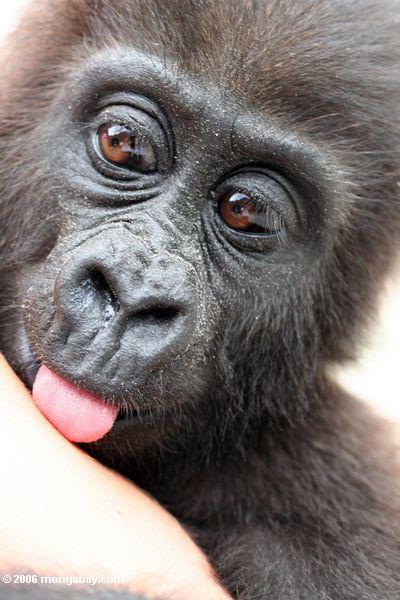 |
| Close up http://www.mongabay.com/images/gabon/600/gabon_1577.JPG |
5. Extreme Close-Up
An Extreme close up is a really close shot to what you are shooting. i.e. If you were shooting someone talking, an extreme close up shot would be of their mouth moving as they talked.
 |
| Extreme Close Up http://www.visualphotos.com/photo/2x3514184/young_mans_eye_extreme_close-up_faa019000234.jpg |
Camera Angles
1. The Bird's-Eye view
The Birds Eye View shot is a over head shot. ie. Filming a busy street from above, only seeing peoples heads.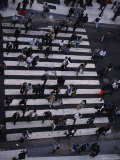 |
| Birds eye view shot of busy crosswalk http://cache2.allpostersimages.com/p/MED/28/2878/KY1PD00Z/posters/birds-eye-view-of-a-busy-crosswalk-on-a-buenos-aires-street.jpg |
2. High Angle
A High angle is when the camera is up high (normally off the ground) shooting the subject below it.
 |
| High Angle Shot http://www.bbc.co.uk/devon/content/images/2007/05/21/wembley_high_angle_465x349.jpg |
3. Eye Level
An Eye level shot is considered a neutral shot. It is when the camera is as if it is a bystander, watching the scene.
 |
| Eye Level http://www.hp.com/canada/portal/hho/digital_photography/take_better_photos/tips/images/tbpb_1_275.jpg |
4. Low Angle
A Low angle is when the camera is below a subject and is shooting up like in action movies or thrillers. It can also be used to make someone or something look extremely tall.
| Low angle http://www.vagabondish.com/wp-content/uploads/eiffel-tower-low-angle.jpg |
5. Oblique/Canted Angle
A Canted or Oblique angle is when the angle is tilted one way or not balanced. This shot can be used to show someone who is unbalanced. ie. in a circus movie, they could shoot someone as they were on a tight rope and as they wobbled from side to side, the camera could tilt from side to side, following the subject.
 |
| Canted or Oblique angle http://fc04.deviantart.net/fs50/f/2009/308/6/b/Oblique_Canted_angle_Shot_by_Gene_G_Shadowwolf.jpg |
Camera Movement
1. Pans
Panning is when the camera is scanning a scene horizontally. Normally the camera will be placed on a tripod and be spun around to see the surroundings.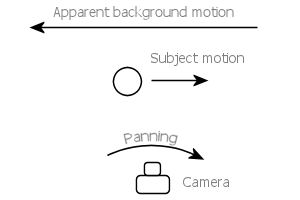 |
| Panning Diagram http://photodoto.com/wp-content/uploads/2006/05/panning_diagram.jpg |
2. Tilts
Tilting is similar to panning although tilting is when the camera is moving vertically.
A Dolly shot is when the camera is placed on a moving vehicle and is following a subject. This shot can be used in Action or Thriller movies. It is good for showing movement or a chase scene.
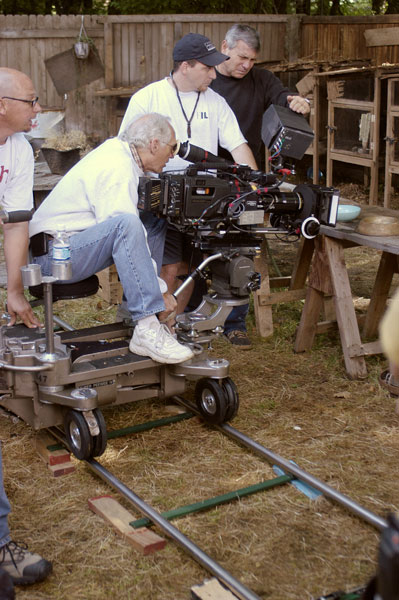 |
| Dolly Shot http://www.benji.com/production/gallery/dolly_puppies.jpg |
4. Hand-held shots
A Hand-held shot is when you are holding the camera and filming something (not having it on a tripod). |
| Hand-held Shot http://fourthlinefilms.files.wordpress.com/2010/08/randy-hand-held.jpg |
5. Crane Shots
A Crane shot is where the camera is on a crane and is following something in the air, for example, the camera could be following a helicopter or a balloon floating away.| Crane Shot http://cogitotv.com/wp-content/uploads/2008/12/crane-shot.jpg |
6. Zoom Lenses
Zooming is the optical lenses in the camera which change smoothly and slowly from a long shot to a closeup or extreme close up shot. |
| Zoom Shot http://iphoneindia.gyanin.com/wp-content/uploads/2009/04/camera-zoom.jpg |
7. The Aerial Shot
An Ariel shot is a shot which is like a crane shot or a dolly shot but from even higher - on a helicopter or airplane. |
| Aerial Shot http://upload.wikimedia.org/wikipedia/commons/3/36/Sonoma_Lake_aerial_view.jpg |
Monday, February 14, 2011
Creating our first story board
Last class, We continued on the warm up task in creating a story board by taking pictures and putting them into a photo storyboard. Here is what we did.
Monday, February 7, 2011
Monday 7th of February 2011
Today was our first film class. Todays class mainly consisted of a general housekeeping powerpoint and a warm up introductory activity. Although i think we got off to somewhat of a slow start, i think that my group did well in the script writing activity.
IB Learner Profile
How can I be better at ________ / better in ______?
Inquirers
They develop their natural curiosity. They acquire the skills necessary to conduct inquiry and research and show independence in learning. They actively enjoy learning and this love of learning will be sustained throughout their lives.
I can be a better inquirer by asking questions in class.
Knowledgeable
They explore concepts, ideas and issues that have local and global significance. In so doing, they acquire in-depth knowledge and develop understanding across a broad and balanced range of disciplines.
I can be more knowledgeable about the concepts, ideas and issues discussed/ brought up by researching into them further.
Thinkers
They exercise initiative in applying thinking skills critically and creatively to recognize and approach complex problems, and make reasoned, ethical decisions.
I can become a better thinker by thinking something clearly through before proceeding with a task.
Communicators
They understand and express ideas and information confidently and creatively in more than one language and in a variety of modes of communication. They work effectively and willingly in collaboration with others.
I can become a better communicator by communicating with others and suggesting ideas when working in groups.
Principled
They act with integrity and honesty, with a strong sense of fairness, justice and respect for the dignity of the individual, groups and communities. They take responsibility for their own actions and the consequences that accompany them.
I can be principled by acting with integrity and honesty, strong fairness, justice and respect for others.
Open-minded
They understand and appreciate their own cultures and personal histories, and are open to the perspectives, values and traditions of other individuals and communities. They are accustomed to seeking and evaluating a range of points of view, and are willing to grow from the experience.
I can be more open-minded by experimenting with different programs and effects when working in Film class.
Caring
They show empathy, compassion and respect towards the needs and feelings of others. They have a personal commitment to service, and act to make a positive difference to the lives of others and to the environment.
I can not only be caring by helping others with anything they need and being respectful of their feelings but also by being respectful towards school equipment that i use and borrow.
Risk-takers
They approach unfamiliar situations and uncertainty with courage and forethought, and have the independence of spirit to explore new roles, ideas and strategies. They are brave and articulate in defending their beliefs.
I can be a risk taker by experimenting/approaching different unfamiliar situations with bravery and courage.
Balanced
They understand the importance of intellectual, physical and emotional balance to achieve personal well-being for themselves and others.
I can be balanced by balancing intellectual, physical and emotional tasks so that you maintain well balanced.
Reflective
They give thoughtful consideration to their own learning and experience. They are able to assess and understand their strengths and limitations in order to support their learning and personal development.
I can be reflective by using this blog and through visual images to not only reflect on what we do in each class but also to give my views on other things like movie reviews.
I can be reflective by using this blog and through visual images to not only reflect on what we do in each class but also to give my views on other things like movie reviews.
Subscribe to:
Comments (Atom)

